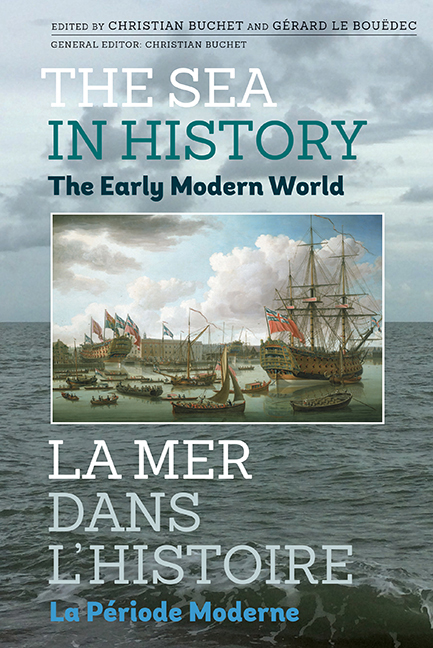Book contents
- Frontmatter
- Contents
- List of Illustrations
- List of Contributors
- Introduction générale et remerciements par
- General introduction and acknowledgements
- Introduction (français)
- Introduction (English)
- LA RÉUSSITE PAR LA MER:La reussite par la mer des territoires et des communautés littorales
- La construction d'un espace mondial: La circulation maritime et les ports
- La forte croissance de l'économie des pêches et des échanges
- Les acteurs de la dynamique maritime
- LA PUISSANCE MARITIME INSTRUMENT DE LA PUISSANCE POLITIQUE ET D'UNE STRATÉGIE GLOBALE DE RAYONNEMENT VOIRE DE DOMINATION: Les puissances maritimes occidentales
- L'ordre des Hospitaliers de Saint-Jean de Jérusalem, Rhodes et Malte, puissance maritime
- Portugal, the west seafront of Europe
- Les formes complexes de la prédominance de l'Espagne, première puissance mondiale de l'histoire
- Le maritime, fondement de la prédominance commerciale et économique des Provinces-Unies
- The keys to British success: trade as a motor and sea as a centre
- Le modèle français: la recherche par l'état de la prédominance maritime, réussites et échecs
- L'Europe Centrale et la mer à l'époque moderne
- Swedish and Danish rivalry to become great powers seen through the development of naval and merchant fleets
- Ambiguous relations between Russia and the sea: causes and consequences
- L'océan Indien, entre convoitises et indifférences
- Les puissances maritimes asiatiques
- L'Afrique
- La politique maritime et l'idéologie
- Mer et développement technologique
- Développement maritime et maîtrise économique et financière
- Développement maritime et maîtrise organisationnelle
- Conclusion (français)
- Conclusion (English)
- Conclusion générale par
- General conclusion by
- Miscellaneous Endmatter
- Miscellaneous Endmatter
L'Europe Centrale et la mer à l'époque moderne
from LA PUISSANCE MARITIME INSTRUMENT DE LA PUISSANCE POLITIQUE ET D'UNE STRATÉGIE GLOBALE DE RAYONNEMENT VOIRE DE DOMINATION: Les puissances maritimes occidentales
Published online by Cambridge University Press: 11 May 2017
- Frontmatter
- Contents
- List of Illustrations
- List of Contributors
- Introduction générale et remerciements par
- General introduction and acknowledgements
- Introduction (français)
- Introduction (English)
- LA RÉUSSITE PAR LA MER:La reussite par la mer des territoires et des communautés littorales
- La construction d'un espace mondial: La circulation maritime et les ports
- La forte croissance de l'économie des pêches et des échanges
- Les acteurs de la dynamique maritime
- LA PUISSANCE MARITIME INSTRUMENT DE LA PUISSANCE POLITIQUE ET D'UNE STRATÉGIE GLOBALE DE RAYONNEMENT VOIRE DE DOMINATION: Les puissances maritimes occidentales
- L'ordre des Hospitaliers de Saint-Jean de Jérusalem, Rhodes et Malte, puissance maritime
- Portugal, the west seafront of Europe
- Les formes complexes de la prédominance de l'Espagne, première puissance mondiale de l'histoire
- Le maritime, fondement de la prédominance commerciale et économique des Provinces-Unies
- The keys to British success: trade as a motor and sea as a centre
- Le modèle français: la recherche par l'état de la prédominance maritime, réussites et échecs
- L'Europe Centrale et la mer à l'époque moderne
- Swedish and Danish rivalry to become great powers seen through the development of naval and merchant fleets
- Ambiguous relations between Russia and the sea: causes and consequences
- L'océan Indien, entre convoitises et indifférences
- Les puissances maritimes asiatiques
- L'Afrique
- La politique maritime et l'idéologie
- Mer et développement technologique
- Développement maritime et maîtrise économique et financière
- Développement maritime et maîtrise organisationnelle
- Conclusion (français)
- Conclusion (English)
- Conclusion générale par
- General conclusion by
- Miscellaneous Endmatter
- Miscellaneous Endmatter
Summary
RÉSUMÉ. À première vue, la mer n'est à peu près pour rien dans les réussites et les échecs des états d'Europe centrale. Pourtant, à certains moments décisifs, le facteur maritime a joué, positivement ou négativement. L'Europe centrale s'est vue largement écartée de la mer par des états aux territoires dispers's sur différents rivages et qui ont entendu s'approprier les flots. Il en va ainsi, par exemple, de la Suède qui, forte de sa marine, a bénéficié d'une capacité de projection de puissance très à l'intérieur de cette Europe centrale. Impériaux et Polonais ont payé cher, les uns de n'avoir pu développer à temps leur instrument naval, les autres de n'avoir su le maintenir. Les Habsbourg, au faite de leur puissance en 1629, n'ont pu empêcher le débarquement de Gustave- Adolphe l'année suivante et l'installation durable de la Suède dans le nord de l'Empire. De même, cette contribution montre également que, dans bien des conflits, l'Autriche et la Prusse n'auraient pu tenir sans alliés maritimes.
ABSTRACT. At first glance, the sea had little to do with the successes and failures of the central European States. However, at specific decisive times, the maritime factor came into play positively or negatively. Central Europe was basically separated from the sea by the states with territories disposed on the different coasts and which went about acquiring fleets. This is the way that Sweden, as an example, with a strong navy, benefited from a capacity to project its strength far inland in this central Europe. The Soldiers of the Holy Roman Empire army and the Polish paid a heavy price, the former in not having developed in time their naval force, the latter in not having succeeded in holding on to it. At the height of their power in 1629, the Hapsburgs were not able to block the arrival of Gustave-Adolphe the following year and the successful installation of Swedes in the north of the Empire. In the same way, this article shows that in numerous Austrian–Prussian conflicts, neither state could have held out without their maritime allies.
Le coeur du continent européen forme un isthme massif entre Trieste et Stettin, bordé à l'ouest par les péninsules, italienne au sud, danoise au nord et à l'est par les évasements constitués par les Balkans et les Pays baltes.
- Type
- Chapter
- Information
- The Sea in History - The Early Modern World , pp. 486 - 495Publisher: Boydell & BrewerPrint publication year: 2017



